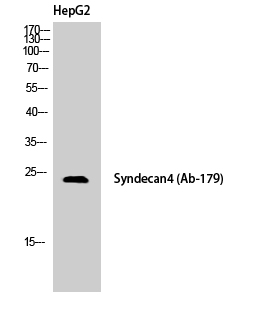
Catalog: YP1150
Size
Price
Status
Qty.
200μL
$600.00
In stock
0
100μL
$340.00
In stock
0
50μL
$190.00
In stock
0
Add to cart


Collected


Collect
Main Information
Target
Syndecan-4
Host Species
Rabbit
Reactivity
Human, Mouse, Rat
Applications
IHC, IF, ELISA
MW
22kD (Calculated)
Conjugate/Modification
Phospho
Detailed Information
Recommended Dilution Ratio
IHC 1:100-1:300; IF 1:200-1:1000; ELISA 1:20000; Not yet tested in other applications.
Formulation
Liquid in PBS containing 50% glycerol, 0.5% BSA and 0.02% sodium azide.
Specificity
Phospho-Syndecan-4 (S179) Polyclonal Antibody detects endogenous levels of Syndecan-4 protein only when phosphorylated at S179.The name of modified sites may be influenced by many factors, such as species (the modified site was not originally found in human samples) and the change of protein sequence (the previous protein sequence is incomplete, and the protein sequence may be prolonged with the development of protein sequencing technology). When naming, we will use the "numbers" in historical reference to keep the sites consistent with the reports. The antibody binds to the following modification sequence (lowercase letters are modification sites):EGsYD
Purification
The antibody was affinity-purified from rabbit antiserum by affinity-chromatography using epitope-specific immunogen.
Storage
-15°C to -25°C/1 year(Do not lower than -25°C)
Concentration
1 mg/ml
MW(Calculated)
22kD
Modification
Phospho
Clonality
Polyclonal
Isotype
IgG
Related Products
Antigen&Target Information
Immunogen:
The antiserum was produced against synthesized peptide derived from human Syndecan4 around the phosphorylation site of Ser179. AA range:145-194
show all
Specificity:
Phospho-Syndecan-4 (S179) Polyclonal Antibody detects endogenous levels of Syndecan-4 protein only when phosphorylated at S179.The name of modified sites may be influenced by many factors, such as species (the modified site was not originally found in human samples) and the change of protein sequence (the previous protein sequence is incomplete, and the protein sequence may be prolonged with the development of protein sequencing technology). When naming, we will use the "numbers" in historical reference to keep the sites consistent with the reports. The antibody binds to the following modification sequence (lowercase letters are modification sites):EGsYD
show all
Gene Name:
SDC4
show all
Protein Name:
Syndecan-4
show all
Other Name:
SDC4 ;
Syndecan-4 ;
SYND4 ;
Amphiglycan ;
Ryudocan core protein
Syndecan-4 ;
SYND4 ;
Amphiglycan ;
Ryudocan core protein
show all
Database Link:
Background:
The protein encoded by this gene is a transmembrane (type I) heparan sulfate proteoglycan that functions as a receptor in intracellular signaling. The encoded protein is found as a homodimer and is a member of the syndecan proteoglycan family. This gene is found on chromosome 20, while a pseudogene has been found on chromosome 22. [provided by RefSeq, Jul 2008],
show all
Function:
Function:Cell surface proteoglycan that bears heparan sulfate.,Function:Cell surface proteoglycan.,similarity:Belongs to the syndecan proteoglycan family.,subunit:Homodimer. Interacts with CDCP1, with GIPC PDZ domain and with NUDT16L1/SDOS (By similarity). Interacts with SDCBP.,tissue specificity:Expressed in epithelial and fibroblastic cells.,
show all
Cellular Localization:
[Isoform 1]: Membrane ; Single-pass type I membrane protein . Secreted . Shedding of the ectodomain produces a soluble form. .; [Isoform 2]: Secreted.
show all
Tissue Expression:
Expressed in epithelial and fibroblastic cells.
show all
Research Areas:
>>ECM-receptor interaction ;
>>Cell adhesion molecules ;
>>Proteoglycans in cancer ;
>>Fluid shear stress and atherosclerosis
>>Cell adhesion molecules ;
>>Proteoglycans in cancer ;
>>Fluid shear stress and atherosclerosis
show all
Signaling Pathway
Reference Citation({{totalcount}})
Catalog: YP1150
Size
Price
Status
Qty.
200μL
$600.00
In stock
0
100μL
$340.00
In stock
0
50μL
$190.00
In stock
0
Add to cart


Collected


Collect
Recently Viewed Products
Clear allPRODUCTS
CUSTOMIZED
ABOUT US
Toggle night Mode
{{pinfoXq.title || ''}}
Catalog: {{pinfoXq.catalog || ''}}
Filter:
All
{{item.name}}
{{pinfo.title}}
-{{pinfo.catalog}}
Main Information
Target
{{pinfo.target}}
Reactivity
{{pinfo.react}}
Applications
{{pinfo.applicat}}
Conjugate/Modification
{{pinfo.coupling}}/{{pinfo.modific}}
MW (kDa)
{{pinfo.mwcalc}}
Host Species
{{pinfo.hostspec}}
Isotype
{{pinfo.isotype}}
Product {{index}}/{{pcount}}
Prev
Next
{{pvTitle}}
Scroll wheel zooms the picture
{{pvDescr}}




















